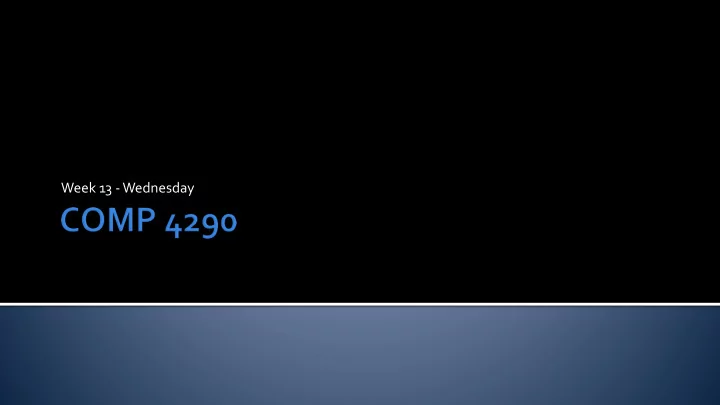

Week 13 -Wednesday
Image based effects Skyboxes Lightfields Sprites Billboards Particle systems
An impostor is a billboard created on the fly by rendering a complex object to a texture Then, the impostor can be rendered more cheaply This technique should be used to speed up the rendering of far away objects The resolution of the texture should be at least: object size screen resolution ⋅ ⋅ 2 distance tan(fov/2)
An impostor that also has a depth map is called a depth sprite This depth information can be used to make a billboard that intersects with real world objects realistically The depth in the image can be compared against the z-buffer Another technique is to use the depth information to procedurally deform the billboard
Impostors have to be recomputed for different viewing angles Certain kinds of models (trees are a great example) can be approximated by a cloud of billboards Finding a visually realistic set of cutouts is one part of the problem The rendering overhead of overdrawing is another Billboards may need to be sorted if transparency effects are important
Image processing takes an input image and manipulates it Blurring Edge detection Any number of amazing filters Much of this can be done on the GPU And needs to be (blurring shadows) Photoshop and other programs are GPU accelerated these days
From Project 1, you guys know all about convolution filtering kernels I just wanted to point out that some kernels are separable Rows and columns can be done separately A separable m x m kernel can be run in 2 mn 2 time instead of m 2 n 2 time
Color correction takes an existing image and converts each of its colors to some other color Important in photo and movie processing Special effects Time of day effects
Tone mapping takes a wide range of luminances and maps them to the limited range of the computer's screen To properly simulate the relative luminances Some bright areas are made extremely bright Some dark areas are made extremely dark We can look for the brightest pixel and scale on that basis
Lens flare is an effect caused by bright light hitting the crystalline structure of a camera lens Actually happens less and less now that camera technology has improved They can be rendered with textures The bloom effect is where bright areas spill over into other areas To render, take bright objects, blur them, then layer over the original scene
In photography, some things are in focus and some things (either too near or too far) are blurry When desired, this effect can be achieved by rendering the image in a range of blurred states and then interpolating between them based on z-value
Fast moving objects exhibit motion blur in films It doesn't often happen in real life We have come to expect it, nevertheless The effect can be reproduced by keeping a buffer of previously rendered frames, adding the latest frame and subtracting the first frame Other techniques can be used to do various kinds of selective, directional blurring
Fog effects can be used to give atmosphere or cue depth Fog is usually based on distance (z-buffer or true distance) from the viewer Different equations determine the effect (linear or exponential) of the fog
BasicEffect makes fog easy with the following members FogEnabled Whether fog is on or off FogColor Color of the fog FogStart Distance (in world space) where fog starts to appear FogEnd Distance (in world space) where fog covers everything It's also not hard to write shader code that interpolates between fog color and regular color based on distance
Non-photorealistic rendering
Read Chapter 11 Finish Assignment 4 Due Friday before midnight Work on Project 3
Recommend
More recommend